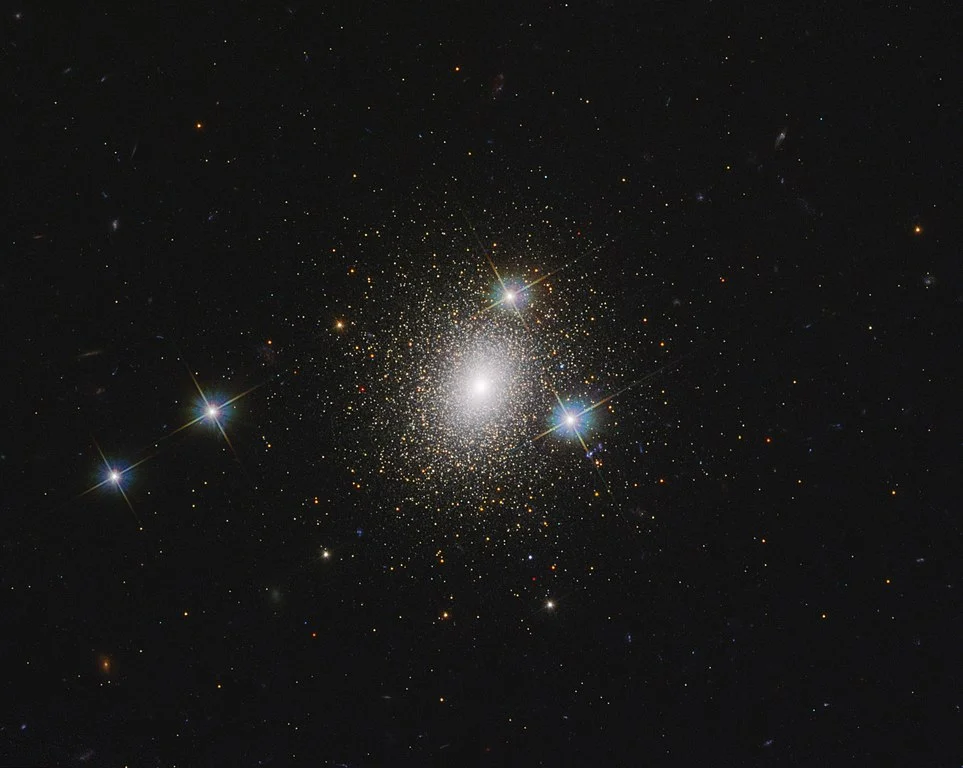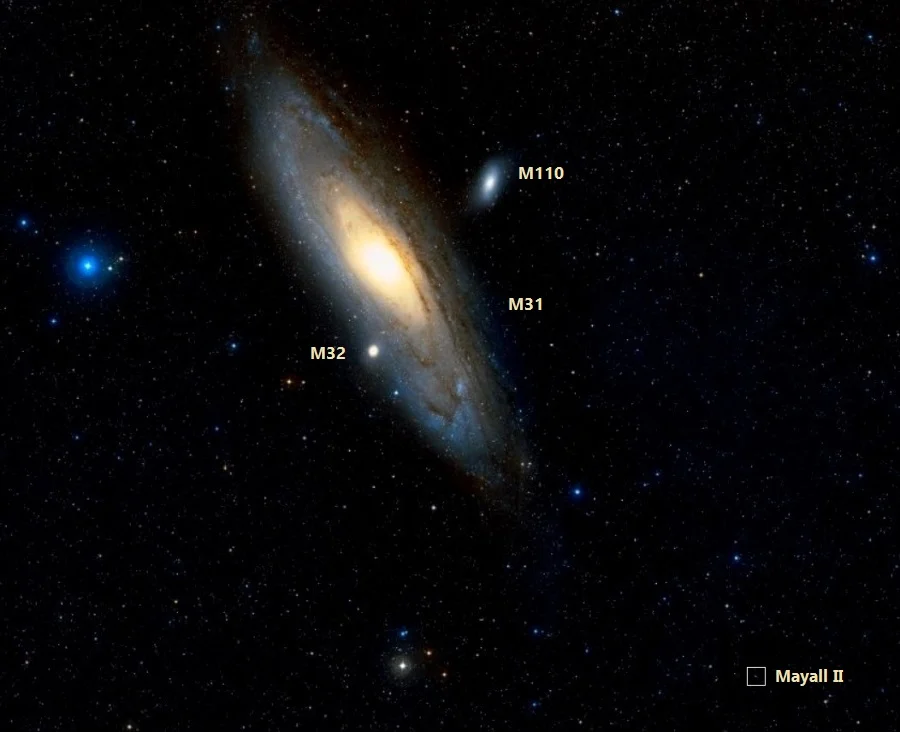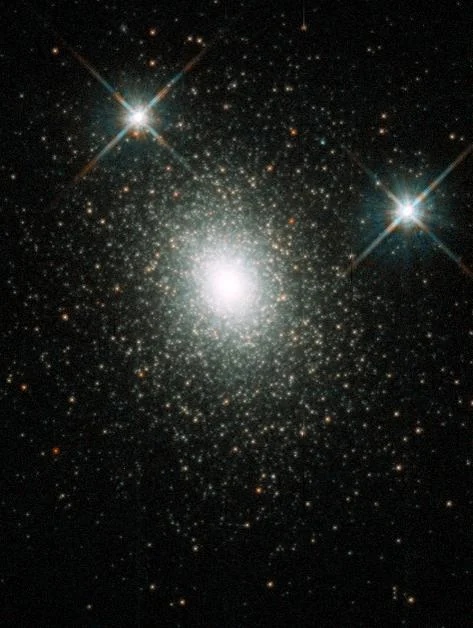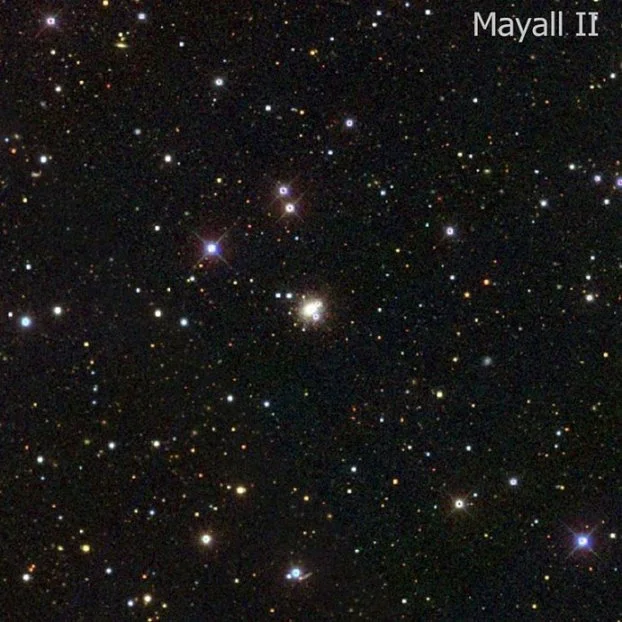Mayall II is a globular cluster orbiting the Andromeda Galaxy (Messier 31). Also known as Andromeda’s Cluster and Globular One (G1), it is the most intrinsically bright globular cluster in the Local Group of galaxies, with an absolute visual magnitude of -10.94 and a luminosity of 2 million Suns. The cluster has an apparent magnitude of 13.81 and lies approximately 2.52 million light years away.

Mayall II lies 130,000 light years from the galactic nucleus of M31. It is located in Andromeda’s halo. With 10 million solar masses, it is more than twice as massive as Omega Centauri, the largest and most massive globular cluster in the Milky Way. Mayall II is also larger, with a tidal radius of 263.2 light years. Andromeda’s Cluster appears similar to our galaxy’s clusters but lies almost 100 times farther away.
The stellar parameters of the cluster’s stars yield an estimated age of 12 billion years, which is comparable to the age of the oldest globular clusters in the Milky Way. These clusters formed when the universe was still quite young and provide insight into an earlier era of galaxy formation.

A study published in 2007 used photometric data obtained with the Advanced Camera for Surveys on the Hubble Space Telescope and derived a core radius of 0.21 ± 0.01 arcseconds (0.78 ± 0.04 parsecs), a half-light radius of 1.73 ± 0.07 arcseconds (6.5 ± 0.3 parsecs), and a tidal radius of 21.8 ± 1.1 arcseconds (80.7 ± 3.9 parsecs) for the cluster.
Like Omega Centauri in the constellation Centaurus, Messier 54 in Sagittarius, and the Intergalactic Wanderer (NGC 2419) in Lynx, Mayall II is believed to be a stripped core of a dwarf galaxy that lost most of its envelope through tidal interactions with a larger galaxy (in the case of Mayall II, the Andromeda Galaxy). Mayall II may host an intermediate mass black hole with about 2×104 solar masses.

The cluster is named after the American astronomer Nicholas U. Mayall who, together with Olin J. Eggen, was the first to identify it as a possible globular cluster in 1953.
Mayall II is known by several other designations, including NGC-224-G1, M31GC J003247+393440, SKHB 1, and HBK 0-1. The latter two designations come from the names of the astronomers who studied the cluster. SKHB 1 comes from the last-name initials of Wallace L. W. Sargent, Charles T. Kowal, F. D. A. Hartwick, and Sidney van den Bergh, who also named the cluster G1 in 1977, while HBK 0-1 is taken from the initials of John Huchra, J. P. Brodie, and S. M. Kent.

Mayall II
| Constellation | Andromeda |
| Right ascension | 00h 32m 46.53s |
| Declination | +39° 34′ 40.5″ |
| Apparent magnitude | 13.81 |
| Angular size | 0.283 x 0.283 arcminutes |
| Distance | 2.52 ± 0.14 million light years (770 ± 40 kiloparsecs) |
| Age | 12 billion years |
| Radial velocity | -332.0 ± 4.2 km/s |
| Mass | 1 x 107 M☉ |
| Radius | 21.2 ± 1.0 light years (6.5 ± 0.3 parsecs) |
| Tidal radius | 263.2 ± 12.7 light years (80.7 ± 3.9 parsecs) |
| Names and designations | Mayall II, Andromeda’s Cluster, Globular One, G1, NGC-224-G1, SKHB 1, HBK 0-1, M31GC J003247+393440 |